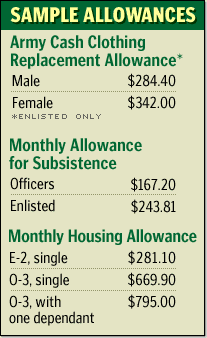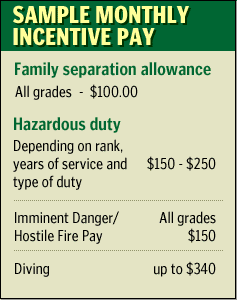NEW YORK (CNN/Money) -
In most jobs you get something called a salary or an hourly wage. You probably also get some other benefits like health insurance, paid vacations and, maybe, life insurance and dental coverage. If you do a good job, your pay goes up. Do a better job and it goes up more.
Not in the military. A service member's "base pay" tells only part of the story. Servicemen and women also get "allowances" to help defray costs for clothing, food and housing. (Click here for a complete table of military base pay by pay grade and corresponding Army rank.)
Base pay, particularly for enlisted service members, is extremely low. Only five occupations listed by the Bureau of Labor Statistics -- including "butlers" and "housekeepers" -- bring less pay than a first-year Private's base pay, according to a survey by outplacement firm Challenger, Gray & Christmas.

After 36 years in the military, General Tommy Franks earns a base pay of $153,948, not including allowances and incentive pay. A typical corporate CEO, on the other hand, earns about $11 million a year.
How allowances and incentives work
Some allowances, like the "Basic Allowance for Subsistence" are actually lower for higher ranks for which the base pay is higher. The "Basic Allowance for Housing" is set according to location, rank and whethere the service member has at least one dependent. The amount does not rise with the number of dependants.
Clothing replacement allowances -- $284.40 for a man in the Army for example, $342.20 for a woman -- are meant to defray the cost of military uniforms. A typical soldier maintains one or two "Class A" uniforms (roughly equivalent to business suits), and at least four "battle dress uniforms" -- two for summer and two for winter conditions.
Battle dress uniforms are the baggy-looking field uniforms and they cost about $55 each. Officers are also required to have at least one dress uniform, the equivalent of an expensive civilian tuxedo costing hundreds of dollars.
A Class A uniform (take off the jacket and it's a "class B") can cost about $180 for an inexpensive off-the-rack outfit. A tailored Class A uniform can cost much as $600, said Maj. Amy Hannah, an Army spokeswoman.
The Basic Allowance for Subsistence -- $167.20 a month for officers and $262.50 for enlisted members (slightly less if cheaper, government provided meals are available where the member is stationed) -- is meant to defray food costs.

Then there's "incentive pay," extra money for performing duties that are in high demand or just not very popular. Navy submarine duty, for example, can bring in up to $425 a month depending on rank and time of service.
Working in a "combat zone" brings an additional $150 a month. Service members operating under actual combat conditions get "Hostile fire/Imminent danger" pay of $150 a month for that service.
How it all comes out
Not all of the money a service member makes is subject to income taxes. Most allowances are tax-exempt. Any money earned while working in a combat zone also is tax-free. (If any part of a month is served in a combat zone, that entire month's pay is tax-free.)
The Department of Defense Military Pay Web site provides some examples of how typical Service Members' paychecks break down.
A married Air Force Captain who has been in the service for eight years, currently stationed at Wright-Patterson Air Force Base near Dayton, Ohio, makes a basic annual salary of $48,841.20. If she gets a $10,140 annual housing allowance -- $845 a month -- and a subsistence allowance of $1,996.44 -- $166.37 a month – that would mean she gets total cash pay of $60,977.64 a year. Since part of that pay is non-taxable, that would be equivalent to a $64,622.64 annual salary, according to the DODs calculations. That's about what a low- to mid-level software engineer or commercial loan officer makes in that part of the country, according to data from Salary.com.
An unmarried Marine Corporal stationed at Camp Pendleton in San Diego, Calif., might take home a total of about $32,434.80 after four years of service, according to a DOD example. That would be equivalent to a civilian salary of $35,313.24, according to the DOD, or about the same as a mid-level auto mechanic in that area, according to Salary.com data.
Like civilians, military members do get pay raises. Unlike much of the civilian world, though, military pay raises aren't tied directly to merit. "We give medals for that," said Catherine Ferguson, a spokeswoman for Defense Finance and Accounting Service. Promotions, which bring higher pay, are tied to merit, of course. Simple raises are tied to rank and years of service.
The minimum pay increase, 4.1 percent this year, is set by law at one-half percent above the average private sector increase. (Prior to 1990, military pay increases were capped at one-half percent below private sector increases.) In 2003, the average military pay increase was 4.7 percent. Pay increases for the military in 2001 were the highest in 20 years, averaging 6.9 percent.
Even though pay has been increasing, almost half of service members said they were "dissatisfied" with every aspect of their pay in a Summer, 2002 survey by the Defense Manpower Data Center, part of the DOD. Basic pay was too low, said 48 percent of respondents. Housing allowances were too low according to 47 percent and subsistence allowances were inadequate according to 49 percent of service members.
This story was update on March 27, 2002, with survey data from Challenger, Gray & Christmas and the Defense Manpower Data Center.

|

